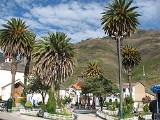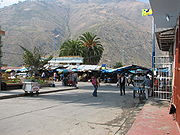
Abancay
Encyclopedia
Abancay is a city in southern-central Peru
. It is the most important city in the Apurímac Region
, and is the capital of the Abancay Province
.
 Abancay is located at an elevation of 2,378 m above sea level in the southern Peruvian Andes
Abancay is located at an elevation of 2,378 m above sea level in the southern Peruvian Andes
, above the Pachachaca River
. Because of its famous year-round warm weather, it is known as "The Eternal Spring Valley". The nearest cities are Cusco
, Chalhuanca and Andahuaylas
. Abancay is located at the junction of two important Peruvian roads: the Caminos del Inca Road, an old road dating since Incan times, between the cities of Nazca and Cusco, and the Via de los Libertadores, between Ayacucho
and Cusco.
arrived, they transliterated the word and named the city Abancay, Villa de los Reyes ("Abancay, Town of the Kings"), which was later reduced to Abancay, its current name.
contest and Yunsa games, with people dressing in local traditional costumes fills the city's streets.
The city's surroundings have some beautiful landscapes, such as the Ampay National Sanctuary
, a wildlife sanctuary located north of the city, on which Apu Ampay (Mount Ampay, the Lord of Ampay, in the indigenous cosmology
) reaches heights of approximately 5,300 meters above sea level; lagoons, waterfalls, wildlife, and the famous Intimpa tree (a unique tropical conifer.)
The Pachachaca River is famous for his colonial bridge and valley where Canyoneering and kayaking
can be practiced in one of the best and longest Peruvian locations for it. Remains of The Pachachaca State, an important producer of sugar and brandy during colonial and republican times, is now part of the city.
The Saywite Archeological Site
is a famous temple and adoration center dating from of Inca times, located a few kilometers from the city. Therein is the world renowned Saywite Stone. The stone is a roughly spherically-shaped monolith
that has a representation of the Inca world. It suggests that the Incas had a much better understanding of astronomy than Europeans used to give them credit for. There is Taxi service from the city.
The Konoc Hot Springs (Cconocc, in Quechua) is a resort located a few kilometers from Saywite and is one of the best places in Peru to enjoy thermal baths from volcanic waters. It is claimed that regular baths in the springs can cure arthritis, asthma, and psoriasis.
Abancay is the gate to the Inca city of Choquequirao
, next to the Apurimac River, which is considered as important as Machu Picchu
. There is evidence that the real dimensions of the city are much larger than what has been uncovered.
and two private universities, Universidad Tecnológica de los Andes and Universidad Alas Peruanas. There are also two college level institutions, Escuela Normal La Salle for teachers and education issues, and SENATI for industrial-related training.
's novel, Deep Rivers. An important book that gives accounts of the history, traditions and customs of the city is "Alma y Rostro de Abancay", by Guillermo Vidalegut, a local journalist and author.
Peru
Peru , officially the Republic of Peru , is a country in western South America. It is bordered on the north by Ecuador and Colombia, on the east by Brazil, on the southeast by Bolivia, on the south by Chile, and on the west by the Pacific Ocean....
. It is the most important city in the Apurímac Region
Apurímac Region
Apurímac is a region in southern-central Peru. It is bordered on the east by the Cusco Region, on the west by the Ayacucho Region, and on the south by the Arequipa and Ayacucho regions...
, and is the capital of the Abancay Province
Abancay Province
The Abancay Province is one of seven provinces of the Apurímac Region in Peru. The capital of the province is the city of Abancay.-Boundaries:*North: Cusco Region*East: Cotabambas Province, Grau Province...
.
Location

Andes
The Andes is the world's longest continental mountain range. It is a continual range of highlands along the western coast of South America. This range is about long, about to wide , and of an average height of about .Along its length, the Andes is split into several ranges, which are separated...
, above the Pachachaca River
Pachachaca River
Pachachaca is a river and valley of the Andes in Peru. Abancay lies on the river and in flows through the Ampay National Sanctuary. It is a notable kayaking location.-References:*...
. Because of its famous year-round warm weather, it is known as "The Eternal Spring Valley". The nearest cities are Cusco
Cusco
Cusco , often spelled Cuzco , is a city in southeastern Peru, near the Urubamba Valley of the Andes mountain range. It is the capital of the Cusco Region as well as the Cuzco Province. In 2007, the city had a population of 358,935 which was triple the figure of 20 years ago...
, Chalhuanca and Andahuaylas
Andahuaylas
Andahuaylas is a Peruvian city, capital of the Andahuaylas Province. It is known as the pradera de los celajes, the prairie of colored clouds. It's approximate population of 34,000 inhabitants makes it the second largest city in the region after the region's capital Abancay.-Location:Andahuyalas is...
. Abancay is located at the junction of two important Peruvian roads: the Caminos del Inca Road, an old road dating since Incan times, between the cities of Nazca and Cusco, and the Via de los Libertadores, between Ayacucho
Ayacucho
Ayacucho is the capital city of Huamanga Province, Ayacucho Region, Peru.Ayacucho is famous for its 33 churches, which represent one for each year of Jesus's life. Ayacucho has large religious celebrations, especially during the Holy Week of Easter...
and Cusco.
History
Abancay was already a populated area before the arrival of the Incas. It was the frontier of the Quechua-Inca influence area to the Chancas, an ethnic native group of Peru. Its name comes from a flower native to the region called Amankay. When the SpanishSpanish people
The Spanish are citizens of the Kingdom of Spain. Within Spain, there are also a number of vigorous nationalisms and regionalisms, reflecting the country's complex history....
arrived, they transliterated the word and named the city Abancay, Villa de los Reyes ("Abancay, Town of the Kings"), which was later reduced to Abancay, its current name.
Tourism
The Carnival is the town's main celebration festival. It is famous as one of the best Peruvian ethnomusical festivals. It takes place from the last week of February through the first week of March. The comparsasComparsa
A comparsa is the band which plays a conga during a Latin American Carnival celebration. It consists of a large group of dancers dancing and traveling on the streets, followed by a Carrosa where the musicians play...
contest and Yunsa games, with people dressing in local traditional costumes fills the city's streets.
The city's surroundings have some beautiful landscapes, such as the Ampay National Sanctuary
Ampay National Sanctuary
Ampay National Sanctuary is a wildlife sanctuary located at the base of Mount Ampay, north of the city of Abancay, Peru. Created in 1987, it is located in the department of Apurimac...
, a wildlife sanctuary located north of the city, on which Apu Ampay (Mount Ampay, the Lord of Ampay, in the indigenous cosmology
Cosmology (metaphysics)
Cosmology in metaphysics is the reflection on the totality of all phenomena. It contrasts with physical cosmology, the study of the origin of the universe in scientific terms after the Copernican Revolution....
) reaches heights of approximately 5,300 meters above sea level; lagoons, waterfalls, wildlife, and the famous Intimpa tree (a unique tropical conifer.)
The Pachachaca River is famous for his colonial bridge and valley where Canyoneering and kayaking
Kayaking
Kayaking is the use of a kayak for moving across water. Kayaking and canoeing are also known as paddling. Kayaking is distinguished from canoeing by the sitting position of the paddler and the number of blades on the paddle...
can be practiced in one of the best and longest Peruvian locations for it. Remains of The Pachachaca State, an important producer of sugar and brandy during colonial and republican times, is now part of the city.
The Saywite Archeological Site
Sayhuite
Sayhuite is an archaeological site 47km east of the city Abancay in the province Abancay in the region Apurímac in Peru. The site is regarded as a center of religious worship focusing on water. An important feature on the site is the Sayhuite monolith, a rock with more than 200 geometric and...
is a famous temple and adoration center dating from of Inca times, located a few kilometers from the city. Therein is the world renowned Saywite Stone. The stone is a roughly spherically-shaped monolith
Monolith
A monolith is a geological feature such as a mountain, consisting of a single massive stone or rock, or a single piece of rock placed as, or within, a monument...
that has a representation of the Inca world. It suggests that the Incas had a much better understanding of astronomy than Europeans used to give them credit for. There is Taxi service from the city.
The Konoc Hot Springs (Cconocc, in Quechua) is a resort located a few kilometers from Saywite and is one of the best places in Peru to enjoy thermal baths from volcanic waters. It is claimed that regular baths in the springs can cure arthritis, asthma, and psoriasis.
Abancay is the gate to the Inca city of Choquequirao
Choquequirao
Choquequirao is a ruined Inca city in south Peru, similar in structure and architecture to Machu Picchu. The ruins are buildings and terraces at levels above and below Sunch'u Pata, the truncated hill top...
, next to the Apurimac River, which is considered as important as Machu Picchu
Machu Picchu
Machu Picchu is a pre-Columbian 15th-century Inca site located above sea level. It is situated on a mountain ridge above the Urubamba Valley in Peru, which is northwest of Cusco and through which the Urubamba River flows. Most archaeologists believe that Machu Picchu was built as an estate for...
. There is evidence that the real dimensions of the city are much larger than what has been uncovered.
Universities
Abancay, despite its small size, is an important center of higher education. The city is home of one state university Universidad Nacional Micaela Bastidas de ApurimacUniversidad Nacional Micaela Bastidas de Apurimac
-External links:*...
and two private universities, Universidad Tecnológica de los Andes and Universidad Alas Peruanas. There are also two college level institutions, Escuela Normal La Salle for teachers and education issues, and SENATI for industrial-related training.
Literary References
This town is the setting of José María ArguedasJosé María Arguedas
José María Arguedas Altamirano was a Peruvian novelist, poet, and anthropologist who wrote mainly in Spanish, although some of his poetry is in Quechua...
's novel, Deep Rivers. An important book that gives accounts of the history, traditions and customs of the city is "Alma y Rostro de Abancay", by Guillermo Vidalegut, a local journalist and author.

